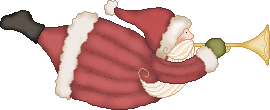 The
Origins of Christmas
The
Origins of Christmas
-
The name Christmas -
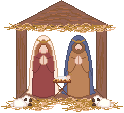 The
name Christmas (originally the Mass of Christ) derives, from
Middle English "Cristes mæsse" or "Christ's
Mass". It is a holiday in the Christian calendar, observed
on December 25, that celebrates the birth of Jesus. The
name Christmas (originally the Mass of Christ) derives, from
Middle English "Cristes mæsse" or "Christ's
Mass". It is a holiday in the Christian calendar, observed
on December 25, that celebrates the birth of Jesus. |
-
Symbols and traditions of Christmas -
 The
modern celebration of Christmas tends to be sometimes more commercial
than religious. The holiday is characterized by gift exchanges
within families, friends and co-workers and by the figure of
Father Christmas or Santa Claus - the gift-bringer, a fat jolly
man with a white beard and a red suit - as well as by other folk
figures from different cultures.
Despite
the influence of American and British Christmas symbols and traditions
spread mainly through literature or television, local and regional
Christmas traditions are very rich and vary from country to country. The
modern celebration of Christmas tends to be sometimes more commercial
than religious. The holiday is characterized by gift exchanges
within families, friends and co-workers and by the figure of
Father Christmas or Santa Claus - the gift-bringer, a fat jolly
man with a white beard and a red suit - as well as by other folk
figures from different cultures.
Despite
the influence of American and British Christmas symbols and traditions
spread mainly through literature or television, local and regional
Christmas traditions are very rich and vary from country to country.
 Most
of the familiar traditional practices and symbols of Christmas,
such as the Christmas tree, the eating of ham, the hanging of
boughs, the Yule Log, the mistletoe and the giving of presents
come from Germany and were adapted by Christian missionaries
from the earlier Germanic pagan midwinter holiday of Yule.
The
Yule, very popular in northern Europe long before the arrival
of Christianity, was the winter solstice celebration of the Germanic
pagans. The winter solstice is the moment when one hemisphere
of the Earth is most inclined away from the Sun. The day of the
winter solstice matks the shortest day and the longest night
of the year. In the northern hemisphere, the winter solstice
usually falls on December 21/December 22, which is the southern
hemisphere's summer solstice. The word for Christmas in the Scandinavian
languages is still today the pagan jul (=yule). Most
of the familiar traditional practices and symbols of Christmas,
such as the Christmas tree, the eating of ham, the hanging of
boughs, the Yule Log, the mistletoe and the giving of presents
come from Germany and were adapted by Christian missionaries
from the earlier Germanic pagan midwinter holiday of Yule.
The
Yule, very popular in northern Europe long before the arrival
of Christianity, was the winter solstice celebration of the Germanic
pagans. The winter solstice is the moment when one hemisphere
of the Earth is most inclined away from the Sun. The day of the
winter solstice matks the shortest day and the longest night
of the year. In the northern hemisphere, the winter solstice
usually falls on December 21/December 22, which is the southern
hemisphere's summer solstice. The word for Christmas in the Scandinavian
languages is still today the pagan jul (=yule). |
-
The gift-bringer -
|
|
Gift-giving
is the most common part of Christmas celebrations around the
world. The concept of a folklore figure who brings gifts to children
derives from Saint Nicholas, Bishop of Myra, an area in present
day Turkey. St. Nicholas was born in Lycia, Asia Minor, and died
as Bishop of Myra in 352. He was said to be a generous good-hearted
man of the 4th century, particularly devoted to children. |
After
his death his kindness and reputation for generosity gave rise
to claims he that he could perform miracles and devotion to him
increased. Thousands of churches across Europe were dedicated
to him and some time around the 12th century an official church
holiday was created in his honor. Considered primarily as the
patron saint of children, Nicholas is also invoked by sailors,
merchants, bakers, travelers and pawnbrokers, and with Saint
Andrew is honored as the co-patron of Russia.
Popular
legends have involved Saint Nicholas in a number of stories,
one of which relates Nicholas' charity towards the poor. In one
of them, there was a man who had lost his fortune, thus being
unable to support his three maiden daughters. Nicholas heard
of the man's intentions of turning them into the streets as prostitutes
and secretly threw three bags of gold through a window into the
home, thus providing dowries for the daughters. The three bags
of gold mentioned in this story are said to be the origin of
the three gold balls that form the emblem of pawnbrokers. Another
version explains the origins of the Christmas stockings. According
to it, the three bags of gold were thrown through the chimney
and fell into the stockings which the young women had hung by
the fireplace to dry.
The
Feast of St. Nicholas is celebrated December 6 and the day is
marked by gift-giving and charity. After the Reformation, the
number of European followers of St. Nicholas gradually decreased,
but the legend was kept alive in the Netherlands where the Dutch
spelling of his name Sint Nikolaas was eventually transformed
to Sinterklaas, which in was the inspiration for the myth of
Santa Claus.
|
Sinterklaas
is depicted with a long white beard, wearing a red bishop's dress
including a red mitre, holding a long gold coloured staff with
a fancy curled top in his hand and carrying a book with all the
children's names in it. He also rides a white horse (called Amerigo)
over the rooftops and is assisted by many mischievous helpers
called 'Zwarte Pieten' (black Petes). |
|
On
the evening of December 5, Sinterklaas brings presents to every
child that has been good. Dutch children leave their wooden shoes
by the fireplace so that Sinterklaas can reward the good children
with treats placed inside their shoes - This tradition was taken
by Dutch colonists to North America in the 17th century. The
American and British Santa Claus derives from this festivity,
the name 'Santa Claus' being a degeneration of the Dutch word
Sinterklaas.
In
Germany, children put a boot, called Nikolaus-Stiefel, outside
their front doors on the night of December 5 to December 6 so
that St. Nikolaus can fill them with gifts if they were good.
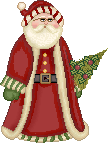 The
Father Christmas name is used widely in the UK, though Santa
Claus is just as commonly used. Father Christmas is also used
in many West African countries. In the Anglo-American tradition,
he arrives on Christmas Eve on a sleigh pulled by reindeer and
climbs down the chimneys of the houses leaving gifts for the
children, who leave food for him. He spends the rest of the year
making toys for the next Christmas.
In
some cultures Santa Claus is assisted by elves in a toy workshop
who make the holiday toys, and in some he is also married to
Mrs. Claus. Many shopping malls in Brazil, North America, the
United Kingdom, Australia and other countries have a holiday
mall Santa Claus whom children can visit to ask for presents
and take pictures. The
Father Christmas name is used widely in the UK, though Santa
Claus is just as commonly used. Father Christmas is also used
in many West African countries. In the Anglo-American tradition,
he arrives on Christmas Eve on a sleigh pulled by reindeer and
climbs down the chimneys of the houses leaving gifts for the
children, who leave food for him. He spends the rest of the year
making toys for the next Christmas.
In
some cultures Santa Claus is assisted by elves in a toy workshop
who make the holiday toys, and in some he is also married to
Mrs. Claus. Many shopping malls in Brazil, North America, the
United Kingdom, Australia and other countries have a holiday
mall Santa Claus whom children can visit to ask for presents
and take pictures. One
belief related to Santa which has been passed down the generations,
is the idea of "good" and "bad" lists of
children. According to it, he would watch the children throughout
the year and add their names to either the good or bad lists
depending on their behavior. Parents would then use the belief
to encourage children to behave well. Those who were on the bad
list and whose behaviour did not improve would not receive the
presents they asked for.
One
belief related to Santa which has been passed down the generations,
is the idea of "good" and "bad" lists of
children. According to it, he would watch the children throughout
the year and add their names to either the good or bad lists
depending on their behavior. Parents would then use the belief
to encourage children to behave well. Those who were on the bad
list and whose behaviour did not improve would not receive the
presents they asked for. |
-
The name Santa Claus in many languages -
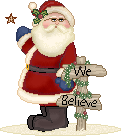 |
Germany:
Nikolaus (ou Weihnachtsmann)
Denmark: Julemanden
Spain and Argentina: Papá Noel
United States: Santa Claus
Finland: Joulupukki
France: Père Noël
England: Father Christmas
Italy: Babbo Natale
Netherlands: Sinterklaas
Russia: Babouschka
Colombia and Mexico: Santa Claus
Portugal: Pai Natal
Brasil: Papai Noel |
|
-
Gifts exchange -
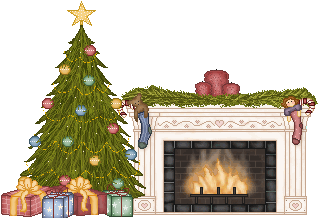 In
many countries, children hang stockings by the fireplace, or,
in case there is not a fireplace, they hang it by the window,
by the door or anywhere else for Santa to fill them with small
gifts on Christmas Eve. In other countries, children place empty
shoes out for Santa to fill on the night before Christmas, or
for Saint Nicholas on the evening of December 5. Gift giving
is not restricted to these gift-bringers, as family members and
friends also exchange gifts on these holidays.
In
many countries, Saint Nicholas' Day remains the principal day
for gift giving and Christmas Day remains more a religious holiday,
in others gifts are given on both days. In other countries, including
Spain, gifts are brought by the Magi at Epiphany on 6 January.
In Russia, Grandfather Frost brings presents on New Year's Eve,
and these are opened on the same night. In most of the
world, Christmas gifts are given at night on Christmas Eve, or
in the morning on Christmas Day.
In
Brazil, Christmas gifts are exchanged on Christmas Eve next to
midnight or a few minutes past midnight (when it is already December
25), after people greet each other with hugs and kisses. Many
families gather on Christmas Eve for the family dinner and after
they greet each other at midnight, they start opening the presents.
Small children, who wait for the gifts delivered by Santa Claus
(called Papai Noel in Portuguese, name that means Father Noel)
may receive gifts from both their parents or other relatives,
but they also wait for the gifts delivered by Papai Noel, which
they will find under the Christmas tree only in the next morning.
It is said that Papai Noel have a magical key wich opens the
doors of all the houses which do not have a chimney, and appartments,
so he can enter and deliver the presents under the tree. In
many countries, children hang stockings by the fireplace, or,
in case there is not a fireplace, they hang it by the window,
by the door or anywhere else for Santa to fill them with small
gifts on Christmas Eve. In other countries, children place empty
shoes out for Santa to fill on the night before Christmas, or
for Saint Nicholas on the evening of December 5. Gift giving
is not restricted to these gift-bringers, as family members and
friends also exchange gifts on these holidays.
In
many countries, Saint Nicholas' Day remains the principal day
for gift giving and Christmas Day remains more a religious holiday,
in others gifts are given on both days. In other countries, including
Spain, gifts are brought by the Magi at Epiphany on 6 January.
In Russia, Grandfather Frost brings presents on New Year's Eve,
and these are opened on the same night. In most of the
world, Christmas gifts are given at night on Christmas Eve, or
in the morning on Christmas Day.
In
Brazil, Christmas gifts are exchanged on Christmas Eve next to
midnight or a few minutes past midnight (when it is already December
25), after people greet each other with hugs and kisses. Many
families gather on Christmas Eve for the family dinner and after
they greet each other at midnight, they start opening the presents.
Small children, who wait for the gifts delivered by Santa Claus
(called Papai Noel in Portuguese, name that means Father Noel)
may receive gifts from both their parents or other relatives,
but they also wait for the gifts delivered by Papai Noel, which
they will find under the Christmas tree only in the next morning.
It is said that Papai Noel have a magical key wich opens the
doors of all the houses which do not have a chimney, and appartments,
so he can enter and deliver the presents under the tree. |
-
Christmas cards -
 Christmas
cards are extremely popular in many countries, in part as a way
to maintain relationships with distant relatives and friends
or with business acquaintances. Christmas
cards are extremely popular in many countries, in part as a way
to maintain relationships with distant relatives and friends
or with business acquaintances. |
-
Christmas Decorations -
 Decorating
a Christmas tree with lights and ornaments, and the decoration
of the interior of the home with garlands and evergreen foliage,
particularly holly and mistletoe, are common traditions. In many
countries, such as Brazil or the United States as well as many
others, it is traditional to decorate the outside of houses or
appartment buildings with lights, and sometimes with illuminated
Christmas figures of sleighs, snowmen or Santa Claus. Decorating
a Christmas tree with lights and ornaments, and the decoration
of the interior of the home with garlands and evergreen foliage,
particularly holly and mistletoe, are common traditions. In many
countries, such as Brazil or the United States as well as many
others, it is traditional to decorate the outside of houses or
appartment buildings with lights, and sometimes with illuminated
Christmas figures of sleighs, snowmen or Santa Claus.
 Since
the 19th century, the traditional Christmas flower is the winter-blooming
poinsettia. A native Mexican plant, poinsettias were named after
Joel R. Poinsett, U.S. ambassador to Mexico who brought the plant
to America in 1828. Poinsettias were likely used by Mexican Franciscans
in their 17th century Christmas celebrations. Other popular holiday
plants are holly, mistletoe, red amaryllis and Christmas cactus. Since
the 19th century, the traditional Christmas flower is the winter-blooming
poinsettia. A native Mexican plant, poinsettias were named after
Joel R. Poinsett, U.S. ambassador to Mexico who brought the plant
to America in 1828. Poinsettias were likely used by Mexican Franciscans
in their 17th century Christmas celebrations. Other popular holiday
plants are holly, mistletoe, red amaryllis and Christmas cactus.
 The
mistletoe was used by Druid priests 200 in their winter celebrations
longer before The
mistletoe was used by Druid priests 200 in their winter celebrations
longer before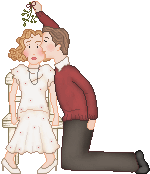 the birth of Christ. The ancient Celtics believed that the plant
had magical healing powers and used it as an antidote for poison,
infertility and to ward of evil spirits. The plant was also seen
as a symbol of peace and it is said that among Romans, enemies
who met under mistletoe would lay down their weapons and embrace.
Scandanavians associated the plant with Frigga, their goddess
of love, and it may be from this that the custom of kissing under
the mistletoe was originated. It is believed that those who kiss
under the mistletoe will have happiness and good luck in the
following year.
the birth of Christ. The ancient Celtics believed that the plant
had magical healing powers and used it as an antidote for poison,
infertility and to ward of evil spirits. The plant was also seen
as a symbol of peace and it is said that among Romans, enemies
who met under mistletoe would lay down their weapons and embrace.
Scandanavians associated the plant with Frigga, their goddess
of love, and it may be from this that the custom of kissing under
the mistletoe was originated. It is believed that those who kiss
under the mistletoe will have happiness and good luck in the
following year. |
|
-
Religious customs and celebrations -
The
religious celebrations begin with Advent, the anticipation of
Christ's birth, around the start of December. These observations
may include Advent carols and Advent calendars, sometimes containing
sweets and chocolate for children. Christmas Eve and Christmas
Day services may include a midnight mass or a Mass of the Nativity,
and feature Christmas carols and hymns. In Brazil, there is a
midnight mass on December 24 called "Missa do Galo"
(Mass of the Rooster). The Midnight Mass is important and is
celebrated at midnight because tradition holds that Christ was
born at midnight. It is celebrated in Rome since the 5th century.
According to one legend, it was said the only time a rooster
ever crowed at midnight was at the moment of the birth of Jesus,
for this reason it is known as the Mass of the Rooster. |
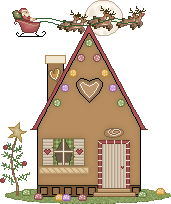 Merry
Christmas!
Merry
Christmas!
|



